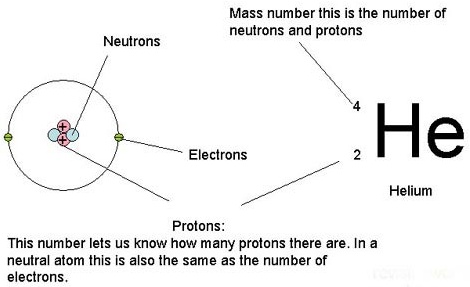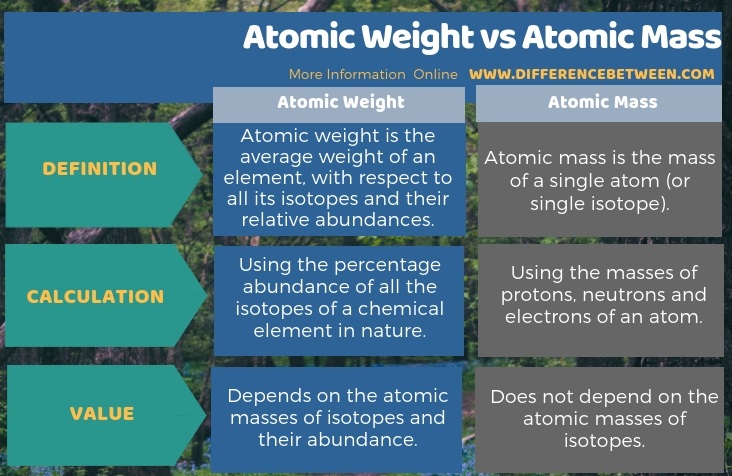Difference Between Atomic Weight and Atomic Mass
The key difference between atomic weight and atomic mass is that atomic weight is the average weight of an element, with respect to all its isotopes and their relative abundances but, atomic mass is the mass of a single atom.
Most people use the terms atomic mass and atomic weight interchangeably. However, they bear different meanings, and it causes a significant error in bulk material calculations if we take these two terms as one.
CONTENTS
1. Overview and Key Difference
2. What is Atomic Weight
3. What is Atomic Mass
4. Side by Side Comparison – Atomic Weight vs Atomic Mass in Tabular Form
5. Summary
What is Atomic Weight?
Atomic weight is the average weight of an element, with respect to all its isotopes and their relative abundances. Most of the times, chemical elements have isotopes; isotopes are the different forms of the same chemical element. Isotopes have the same number of protons (which makes them belong to the same chemical element) and different numbers of neutrons in the atomic nucleus. There are different percentages of different isotopes that occur in nature. We need to consider the atomic masses of all the isotopes and their percentages when getting the atomic weight of a chemical element. There, we can calculate the average mass using the atomic masses of each isotope to get the atomic weight. The atomic weight that we see in the periodic table are calculated according to this phenomenon.
We can use the following two steps for this calculation;
Video 1: Calculating the Atomic Weight
Example: Suppose we have 98% of C-12 isotope and 2% of the C-13 isotope in nature. Let us calculate the atomic weight of carbon using the atomic masses of these isotopes.
- Converting into decimal values:
- Decimal value for the percentage of C-12 is 0.98 (obtained by dividing 98 from 100).
- Decimal value for the percentage of C-13 is 0.02 (obtained by dividing 2 from 100).
- Multiplication of atomic masses of each isotope from the decimal values:
- 12 x 0.98 = 11.76
- 13 x 0.02 = 0.26
- Addition of answers together to get the final answer:
- 76 + 0.26 = 12.02
Eventually, we can get the atomic weight of the chemical element carbon as 12.02 amu (atomic mass units). Moreover, we can name this term as “relative atomic mass” because it is an average of actual atomic masses of isotopes.
What is Atomic Mass?
Atoms mainly contain protons, neutrons and electrons. Atomic mass is simply the mass of an atom. In other words, it is the collection of masses of all the neutrons, protons and electrons in a single atom, specifically, when the atom is not moving (rest mass). We take only the rest mass because according to the fundamentals of physics when atoms are moving at a very high velocity the masses increase. However, the mass of electrons is considerably very small compared to the masses of protons and neutrons. Therefore, we can say that the electrons’ contribution to an atomic mass is less. Hence we can neglect the mass of an electron when calculating the atomic mass. Above all, different isotopes have different atomic masses though they belong to the same chemical element because they have different numbers of neutrons.

Figure 01: We can use the masses of protons, neutrons and electrons of an atom to calculate the Atomic Mass
Moreover, the masses of atoms are extremely small, so we cannot express them in normal mass units like grams or kilograms. For our purposes, we are using another unit call atomic mass unit (amu) to measure the atomic mass. Similarly, 1 atomic mass unit is the one-twelfth of the mass of a C-12 isotope. When we divide a mass of an atom from the mass of one-twelfth of the mass of a C-12 isotope, we can get its relative mass. However, in the general use when we say the relative atomic mass of an element, we mean their atomic weight (because we calculate it considering all the isotopes).
What is the Difference Between Atomic Weight and Atomic Mass?
Most of the times we use the terms atomic weight and atomic mass as the same. However, these two terms differ from each other mainly according to the definition. Therefore, going by the definition, the key difference between atomic weight and atomic mass is that the atomic weight is the average weight of an element, with respect to all its isotopes and their relative abundances whereas the atomic mass is the mass of a single atom.
Furthermore, we can identify another important difference between atomic weight and atomic mass by considering the way of calculating each value; we should calculate the atomic weight using the percentage abundance of all the isotopes of a chemical element in nature while we can calculate the atomic mass simply by adding the masses of protons, neutrons and electrons of an atom.

Summary – Atomic Weight vs Atomic Mass
Atomic weight and atomic mass are two important terms that we often use in chemical calculations. The key difference between atomic weight and atomic mass is that atomic weight is the average weight of an element, with respect to all its isotopes and their relative abundances whereas atomic mass is the mass of a single atom.
Reference:
1. Wichers, Edward, and H. Steffen Peiser. “Atomic Weight.” Encyclopædia Britannica, Encyclopædia Britannica, Inc., 15 Dec. 2017. Available here
2. Helmenstine, Anne Marie, Ph.D. “How to Calculate Atomic Mass.” ThoughtCo, Apr. 1, 2018. Available here
Image Courtesy:
1.”133317385″ by eLearn.Punjab (CC0) via Vimeo
2.”Atomic number depiction”By Materialscientist (CC0) via Commons Wikimedia
ncG1vNJzZmivp6x7pbXFn5yrnZ6YsqOx07CcnqZemLyue8OinZ%2Bdopq7pLGMm5ytr5Wau26t06ikoptdrLKqs8etZJqmlGLDtHnAraamoZNiuqK%2F0mg%3D